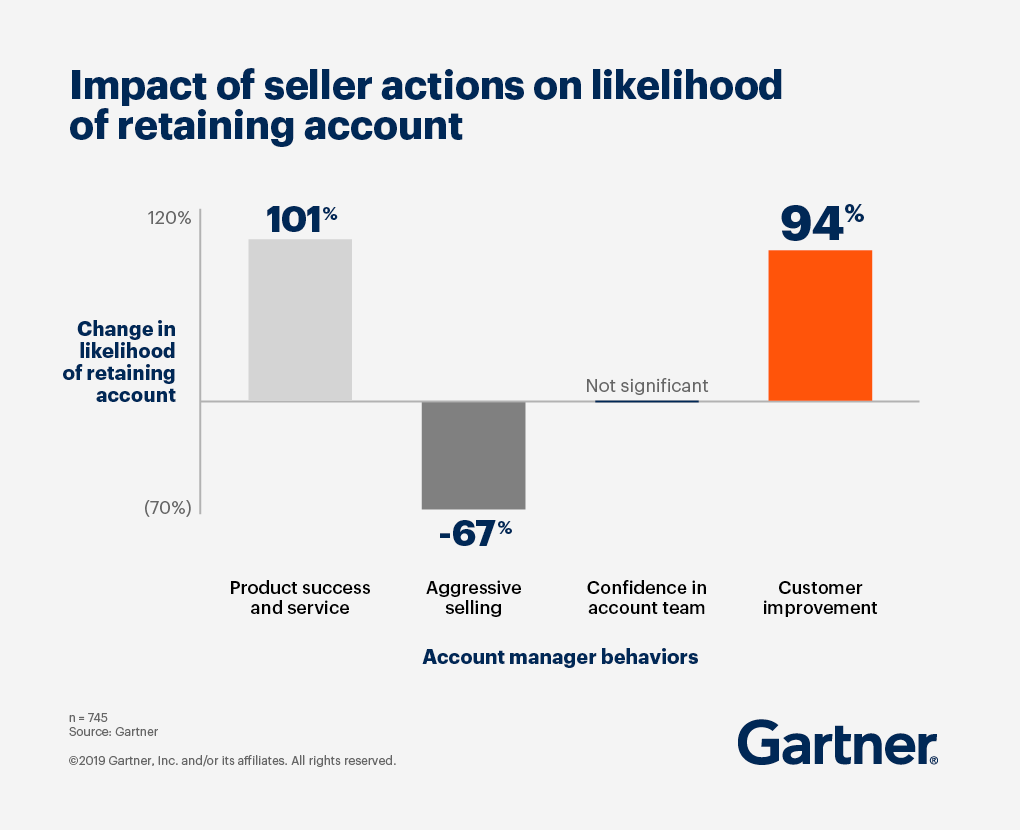So far in our partnership series, we talked about a best-practice process to create net new sales opportunities. To recap: customer-centricity is integral to driving value. Understanding your customers, their industry, their personas, their financial KPIs, and being able to share this information in a way that provokes your customer/prospect into thinking more strategically about their business opens the door for personalized, value-based conversations about your solution and service offerings.
Before we walk you through a practical example in our upcoming webinar, let’s talk about the final step: growing your key accounts and building customer loyalty by delivering measurable business value.
Closing the next deal or ensuring the contract is renewed is NOT based on customer satisfaction.’ Satisfied customers leave all the time – but loyal customers, those that see long-term business value from your products and services will renew and buy more. And the most dependable way to earn loyalty is through measurable success.
More Than Satisfied
If you think about a sales process through the eyes of your customers, they aren’t buying your product or service – they are buying an outcome. There’s an old story about how nobody wants a 3/8” drill bit. What people really want are 3/8” holes. The drill bit is a just means to an end.
That’s what this whole process is really about. The customer is looking to achieve an outcome.
However, a couple of bad things happen way too often. First, the sales team has the wrong perspective – they look at the contract or purchase order as the end of the deal. The customer, on the other hand, looks at the sale as the beginning of a new process – the process of achieving the value promised throughout the sales process.
The second way in which most companies fall short is during the transition from sales to services. Too often, the value the customer wants isn’t relayed to the account support team. At best, the specifications, features, requirements, etc. may be communicated. But if the only yardstick for success is ‘did we satisfy the requirements?’ the chances are pretty high that you’re miles away from delivering the expected value.
Gartner Group conducted a study that shows there is no correlation between post-sale customer service and growing revenue at a customer. However, that same study showed that there is a 48% improvement in revenue growth and 94% improvement in retention if you help deliver ‘Customer Business Improvements.’

A ‘satisfied’ customer should only the starting line. Building loyalty, which comes when you deliver Customer Business Improvements, is the goal.
Measurements That Matter
Sales Leaders and Account Management must work closely with Customer Success partners to the continual development of business value for each customer. Furthermore, those post-sales teams must have a workstream dedicated to help measure the value (or, more likely, measure how we support achieving the value).
Without proper programs in place to measure and monitor client success, it won’t matter how streamlined or customer-centric the sales cycle. That’s troubling news for many companies. In a survey conducted by Revegy and Finlistics, 75%+ of respondents said that they don’t measure realized value consistently or AT ALL!

What Costs Clients, Costs You
As we move further into the ‘Everything as a Service’ economy, sales teams and account managers must document the customers’ expectations around business value. This is NOT functional requirements, NOT Service Level expectations, NOT Quality expectations, but measurable business outcomes that caused them to look for a solution in the first place.
Gallup published a study last year saying 71% of B2B customers are ready and willing to take their business elsewhere….. Say What?
The study goes on to say, “Vendors that make a significant impact on their business can get a 31% higher share of wallet”
If what we want is revenue growth and contract renewal, it falls on us to ensure that our company delivers the business value promised in the sales cycle. And that we measure it and that we share that measured business value with the executives that launched the original evaluation of our solutions. Too many companies don’t get the credit for the value they deliver because they skip this last step.
If you don’t take credit for the value delivered and get the customers buy-in – you run the risk of being one of the suppliers where the customer is ‘ready and willing to switch’.
The WIIFM in sales and account management is a faster path to growing revenue Wouldn’t it be nice to reach out to customer executives with the following message?
“Dear CIO/CMO/CSO, last year you selected us to help you (reduce costs in the supply chain, shorten time to market, improve margins, etc). I’d like to meet with you to review the business impact we delivered to your company from that contract and share with you a couple of other ideas we have about how to help you impact (margins, revenue, costs, security, etc.).”
We all know that it's really hard to get a second meeting with an executive, but if you have a proven history of delivering value, you are far more likely to have regular meetings to discuss new ideas for mutual growth. It’s a clear win for them. And, it’s a clear win for you too!
